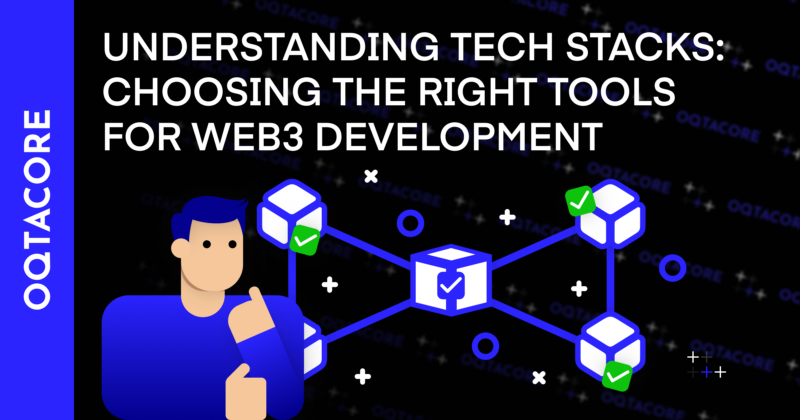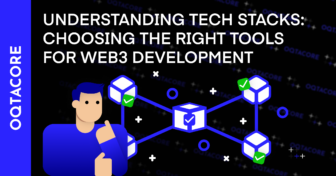
Choosing the Right Tools for Web3 Development
Choosing the right tech stack for your Web3 project is crucial to ensure scalability, security, and long-term success. From the programming languages to the frameworks and development environments, each decision can significantly impact how your application performs. In this article, we will explore how to select the right programming language, discuss the importance of the development environment, and cover the different stages of product development.
Key Factors for Choosing the Right Programming Language
When selecting a programming language for Web3 development, companies must consider several critical factors:
- Developer Availability: How easily can you find developers proficient in this language? Popular languages often have a larger pool of available talent.
- Developer Psychology: Different languages appeal to different types of developers. Some may prefer JavaScriptdue to its widespread use, while others may favor Golang for high-performance applications.
- Suitability for the Task: Is the language optimized for the specific task you’re trying to achieve? For example, Python excels at data analysis and machine learning, while JavaScript is a staple for front-end web development.
- Ecosystem: Does the language have a rich ecosystem of libraries, frameworks, and community support? A strong ecosystem can greatly speed up development and reduce the need to build everything from scratch.
- Code Availability: Are there reusable code libraries available on platforms like GitHub? This can save considerable development time.
- Experience of Developers: Do you have developers with experience in the language you choose? It’s essential to ensure that your team can quickly adopt and work efficiently with the language.
- Developer Pool: Larger companies require a broad talent pool. For that reason, it is often better to choose a language that has a widespread following, such as Java, JavaScript, or Python, to ensure scalability in staffing.
Comparing Popular Programming Languages for Web3 Development
JavaScript
- Strengths: Ideal for web-based applications, and Node.js allows it to be used on the server-side as well.
- Use Cases: Front-end Web3 applications, dApps, integration with blockchain networks (such as Web3.js).
- Developer Community: JavaScript has a large pool of developers and a well-established ecosystem.
Python
- Strengths: Known for its simplicity and excellent libraries for data analysis, machine learning, and AI.
- Use Cases: Smart contract development, data processing, backend development, and blockchain analytics.
- Developer Community: Python has an active community and excellent library support for blockchain-related projects, such as Web3.py.
Golang
- Strengths: A high-performance language ideal for building scalable and concurrent systems. Its simplicity and efficiency make it perfect for high-load systems like blockchain nodes.
- Use Cases: Blockchain nodes, smart contract execution, high-performance decentralized applications (dApps).
- Developer Community: A growing community, particularly within blockchain and distributed systemsdevelopment.
Rust
- Strengths: Focuses on performance, memory safety, and concurrency. It is becoming a popular choice for blockchain development.
- Use Cases: Building secure and efficient blockchain frameworks like Solana.
- Developer Community: Smaller than Go’s, but rapidly growing and backed by blockchain projects such as Polkadot and Solana.
Java and C#
- Strengths: Both are excellent for enterprise software, offering mature frameworks and libraries.
- Use Cases: Enterprise Web3 solutions, smart contracts, and large-scale Web3 systems.
- Developer Community: Both languages have well-established ecosystems, though they are generally not used in blockchain development as extensively as others like JavaScript or Golang.
Frameworks: Accelerating Development
Frameworks help developers speed up the development process by providing a structured environment with predefined tools. When working with Web3, it’s important to choose a framework that fits the specific requirements of your project.
Common Frameworks in Web3:
- React.js: For front-end Web3 development, especially useful for building interactive user interfaces that communicate with blockchain networks.
- Flutter: For cross-platform mobile apps, often used in the blockchain space for creating decentralized mobile applications.
- Truffle Suite: A powerful tool for Ethereum dApp development, providing developers with the tools to write, test, and deploy smart contracts.
- Hardhat: A development environment for compiling, testing, and deploying smart contracts to Ethereum.
Development Environments: Essential for Scalability
The environment refers to the set of tools, libraries, and servers that run and support an application during its lifecycle. It’s essential to understand the different stages of the development process to ensure that each phase runs smoothly.
Types of Development Environments:
- Dev Environment: This is where developers build and test their applications locally, often using virtual machines or cloud-based development tools.
- QA Environment: Used by Quality Assurance (QA) teams to test new features and updates before deployment.
- Staging Environment: The pre-production environment, where the final version of the product is tested with minimal risks to the live system.
- Production Environment: The live, public-facing version of the application where real users interact with the platform.
The Importance of Testing in Web3 Development
Different Types of Testers:
- Manual Testers: They manually execute test cases and report bugs in the system.
- API Testers: These testers work with tools like Postman to ensure that the API endpoints are functioning correctly.
- Automation Testers: They write and maintain automated test scripts using frameworks such as Selenium and Playwright to run tests without human intervention.
Testing Phases:
- Regression Testing: Ensures that new features don’t break existing functionality.
- Performance Testing: Tests how well the application performs under load, ensuring scalability and efficiency.
- Discovery Testing: Testers explore the application and look for vulnerabilities or edge cases that aren’t covered by traditional test cases.
The Stages of Product Development in Web3
Building a Web3 product goes through several stages, and understanding the lifecycle of your product is essential.
Product Development Stages:
- Clickable Prototype: Early mockups and wireframes created using tools like Figma.
- MVP (Minimum Viable Product): The first functional version of the app that solves the user’s problem but may lack some features.
- Beta Version: A full product version, tested internally before releasing to a larger audience.
- Soft Launch: A limited launch to a select audience to test user reactions and performance.
- Hard Launch: The full-scale release, supported by a major marketing campaign.
Conclusion: Building Scalable and Secure Web3 Applications
When building a Web3 product, choosing the right tech stack and development framework is essential for creating a secure, scalable, and efficient application. Whether you’re using native languages like Golang and Rust or hybrid frameworks like React Native, each choice impacts how your product will perform and evolve over time.
By understanding the development environments, stages of product development, and the role of testing, companies can ensure that their Web3 projects meet the demands of the market and their users. The Web3 ecosystem is constantly evolving, and selecting the right tools will help you stay competitive.
Explore More About Web3 Development:
- Understanding Layer-1 and Layer-2 Blockchains
- What Is Crypto Staking and How Does It Work?
- What is DeFi Security
